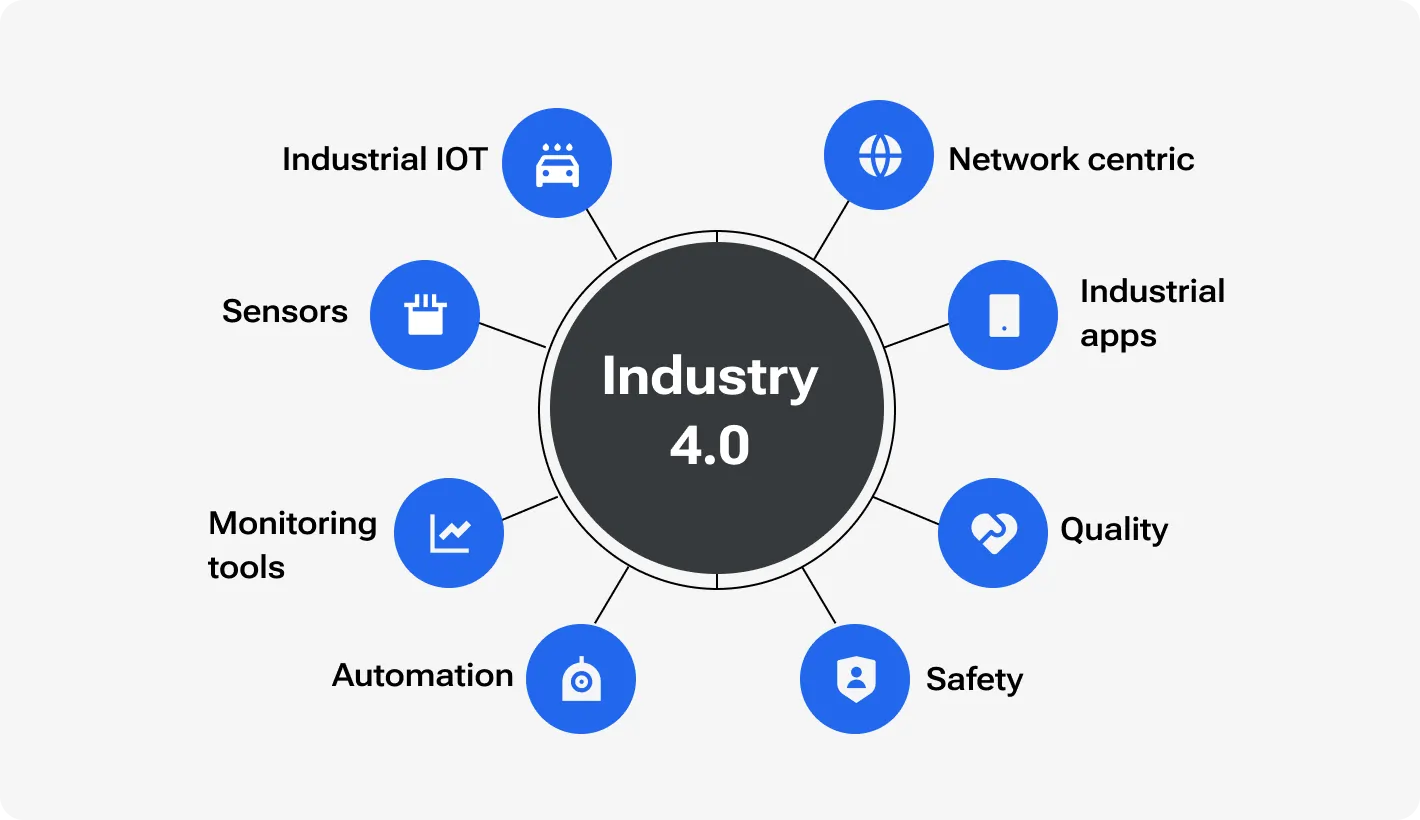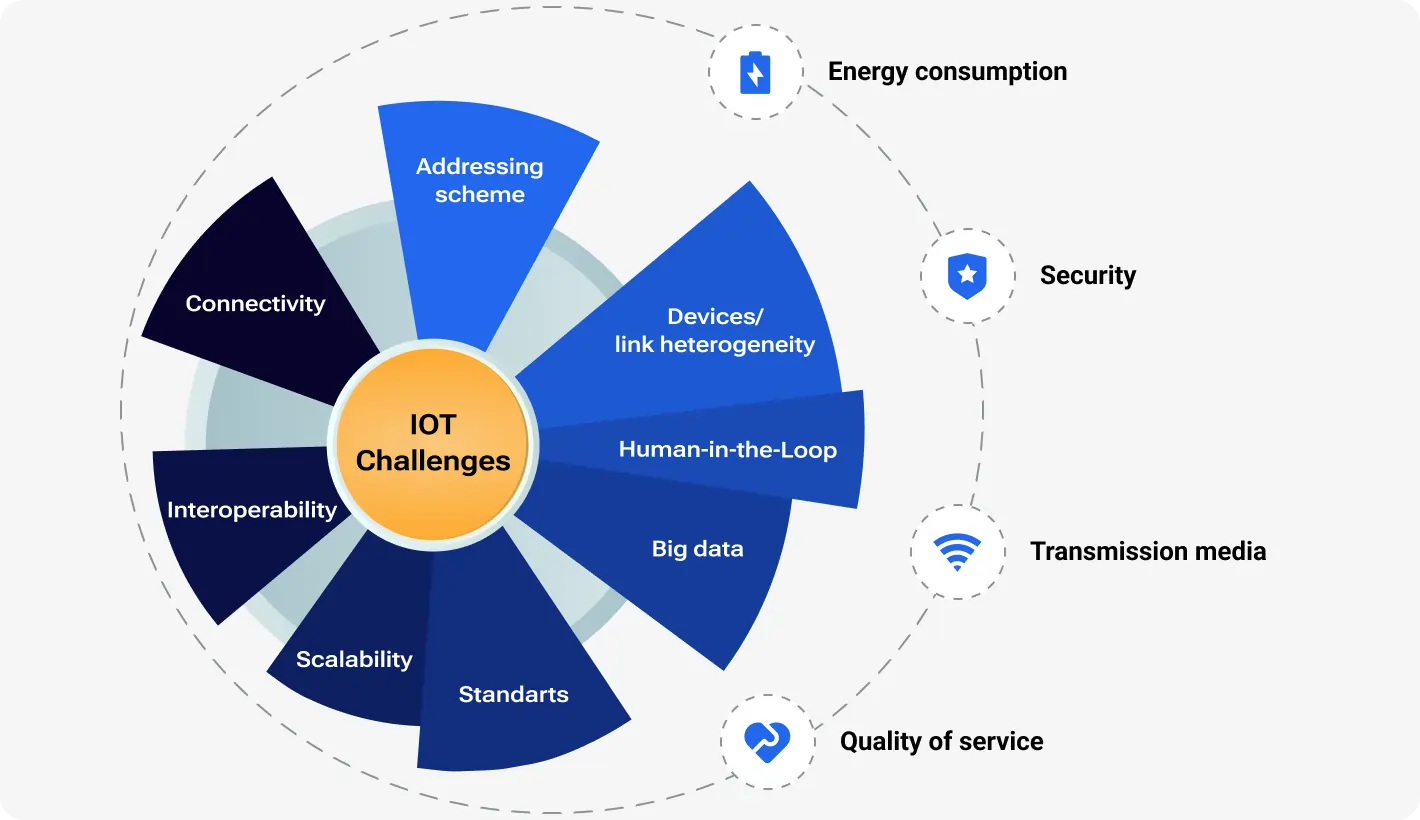Outsourcing to Czechia

How much does it cost to hire developers in Czechia?
Dec 2nd 25 - by Devico Team
Find out how much it costs to hire software developers in Czechia in 2025. Compare hourly rates, roles, and factors that impact pricing.
Hire
Hire by role
Hire Front-end developers
Hire Back-end developers
Hire Full-stack developers
Hire Android developers
Hire iOS developers
Hire Mobile developers
Hire AI engineers
Hire ML engineers
Hire Automation QA engineers
Hire Blockchain developers
Hire Data engineers
Hire Cloud engineers
Hire by skill
Hire JavaScript developers
Hire TypeScript developers
Hire Ruby on Rails developers
Hire React Native developers
Hire Flutter developers
Hire Golang developers
Hire React.js developers
Hire Python developers
Hire PHP developers
Hire .NET developers
Hire Java developers
Hire Laravel developers

Digital transformation
August 26, 2024 - by Devico Team
Summarize with:
The importance of Internet of Things (IoT) solutions in modern business is growing. Every year, more and more business owners are joining the IoT bandwagon to take advantage of IoT integration.
Statista predicts that by 2025, the number of connected devices in the world will reach 75.44 billion, based on an analysis of the installed base of the Internet of Things (IoT) worldwide from 2015 to 2025. With this in mind, you need to know how the IoT can accelerate your business's digital transformation.
Learn all about the connection between the Internet of Things (IoT) and digital transformation. But first, we need to make sure that everyone realizes how important digital transformation is to business success.

What we call "digital transformation" is really just the use of technology to completely revamp a company's processes, goods, and customer service. It helps companies find new ways to save money, be more efficient, and find creative possibilities. Businesses may gain a competitive edge and access previously unrealized value by using digital capabilities.
Technology alone cannot capture the spirit of digital change. Businesses' operations and consumer engagement will need to undergo a dramatic change as a result. Organizations may inspire creativity and create real value for consumers and themselves by using digital technology and IoT platforms to their fullest potential.
As part of their digital transformation, companies are always looking for new methods to improve their operations and the customer experience. Companies in today's complex and ever-changing business climate need to use technology to their advantage if they want to succeed in the long run.
One of the most important motivators for digital transformation is the pressure from the market. Walmart maintained its competitive advantage during the Сovid-19 pandemic by embracing digital transformation early on. This included advanced self-service and grocery delivery systems, robotics, advanced supply chain management, and improved forecasting. Walmart's competitors, like Amazon, also embraced digital transformation.
To stay competitive with tech-savvy startups, established companies must likewise embrace digital transformation. To be future-ready and adaptable in the face of technological upheavals, digital transformation is crucial for the organization.
Companies need to use new technology to adjust their existing business operations to meet the ever-changing demands and expectations of their customers. For better management of internal operations and more customized client experiences, digital transformation in the enterprise is priceless.
IoT is quickly becoming the digital transformation future in many industries, such as transportation, healthcare, government and education, security, communication, and agriculture.
The internet of things has a major effect on digital transformation initiatives because of:
Introducing fresh avenues for financial investment;
Reducing operating expenses;
Enhancing customer experience;
Improving productivity;
Facilitating improved decision-making;
Enabling new business models;
Increasing revenue.
Incorporating IoT technology into contemporary organizations gives various benefits and has led to many entrepreneurs structuring their whole operations around it. Businesses may digitally alter their operations by embracing IoT technologies, which provide several essential advantages. Thus, the function of IoT in digital transformation is different.
Here are some of the important benefits of implementing IoT in digital transformation:
1. Automation of operations
The internet of things (IoT) enables the automation of a wide range of operations, even the most complicated ones. This streamlines procedures, reduces mistakes, and speeds up business innovation while simultaneously boosting efficiency. The internet of things (IoT) also makes data collecting easier, which means companies can get insights and make data-driven decisions based on data that's collected in real time. One good example of a successful implementation of operations automation is Amazon. By acquiring Kiva, Amazon was able to incorporate their technology into their workflows; by replacing people with thousands of Wi-Fi-connected robots, Amazon was able to cut operational expenses by 20%.
This method shortens the time it takes to gather and analyze data, which speeds up development. Numerous advantages accrue to businesses as a result of the Internet of Things' engagement in digital transformation.
2. Connectivity
Internet of things (IoT) devices may facilitate data and information exchange across disparate systems, which in turn can boost cooperation and speed up digital transformation. Businesses may improve productivity, save costs, and boost customer happiness by developing new goods and services that make use of connectivity.
The integration of data sources and the improvement of monitoring and management of linked devices may make this a reality.
3. Oversight and analysis of data
Thanks to the IoT, data can be analyzed and monitored in real time, which gives decision-makers priceless insights. This capability allows businesses to detect trends, foresee issues, and reduce downtime. For example, integrating refrigeration sensors with predictive maintenance software, the pharmaceutical sector may enhance their readiness for equipment breakdown.
Additionally, you may get a better understanding of your consumers' tastes and behaviors with the aid of IoT devices. Plus, it allows businesses to better tailor their offerings to each consumer. This will lead to an increase in both customer loyalty and profitability.
4. Strengthened safety protocols
Additional security measures are included in IoT systems to better safeguard infrastructure and data from any potential threats. Data breaches and other types of cybercrime are less likely to occur as a result. Automating security-related processes utilizing the internet of things will reduce the amount of time and energy needed to maintain a secure environment. Companies will have greater resources to focus on other aspects of their operations as a result.
In addition to effectively protecting data and systems, automated security measures enhance overall security by keeping systems up-to-date.
5. Assists in making better decisions
Digital transformation paves the way for informed decision-making by streamlining the dissemination of useful data. Any method or instrument for data analysis may help businesses monitor key performance indicators and get better insights. With its assistance, better outcomes are possible.
How to develop a winning digital transformation strategy
Every digital transformation project nowadays must include a variety of new technologies such as the internet of things (IoT), artificial intelligence (AI), and augmented reality. One important new technology that will make many digital transformation solutions more useful and easy to use is the internet of things (IoT). Learn more about things to consider and key components of digital transformation in our blog.
Digital business transformation can be implemented through a variety of tactics and technologies. The number of IoT devices expected globally is projected to almost quadruple from 15.9 billion in 2023 to over 32.1 billion in 2030, with China expected to have the largest number of IoT devices in 2033, with over 8 billion consumer devices, according to Statista.
While the specifics may vary depending on the industry, company size, and location, each company has developed a unique and best way to go about it. Below are some typical models and methods:
When selecting IoT technology, your company objectives and technological needs must align. Start by understanding the basics of your IoT solution. Is scalability necessary? Will it integrate seamlessly with your current setup?
Compatibility: Ensure the new technology works with your existing systems.
Scalability: Choose a platform that can grow with your business.
Security: Opt for platforms known for robust security measures. Verify regular updates and security patches.
Support and community: A strong developer community and reliable provider support are essential.
Future planning: Select technology with a good track record of support and advancement.
Having a well-defined architecture plan is crucial before jumping into IoT deployment. Costly mistakes and inefficiencies might result from skipping this step. The first step in implementing IoT is to take stock of your present infrastructure and pinpoint its weak spots. Just think about how IoT might simplify processes and bring you insights into your data in real-time. Sensors, devices, data processors, and user interfaces should all be defined. You may locate possible bottlenecks and regions in need of renovation with the help of this comprehensive map.
It is essential to do pilot testing, not only recommended. Inadequate testing is a common reason why just 26% of internet of things (IoT) projects succeed, according to a Cisco report. To gauge interest, begin with a little undertaking. Collect useful information, pinpoint problems, and hone your strategy throughout this stage. To lessen the likelihood of extensive interruptions, pilot testing lets you refine solutions before a full-scale launch. During this phase, you may make data-driven choices to enhance system performance by continuously monitoring and implementing feedback loops.
Failure and inefficiency are possible outcomes of implementing IoT into preexisting systems without thorough preparation and testing. Your company will be better able to handle the challenges of incorporating new internet of things (IoT) technology into current operations if you follow these steps. This tutorial provides more thorough information on optimizing digital infrastructure.
Dealing with digital change could be a daunting task. But if you divide it into four main steps, you'll find it much simpler.
Digital Data. The ability to evaluate risks and make educated judgments is made possible by digital data collection, which includes information about the market and consumers.
Data analysis. After collecting data, analyze it using analytics tools. Use machine learning and statistical analysis to spot patterns and trends. Know that the role of big data in digital transformation is extremely important and you can't skip this step.
Concluding. To draw practical conclusions, it is necessary to analyze the findings. Make better use of these insights to improve operational efficiency and streamline procedures.
React to insights. Make adjustments to processes or goods in light of the results to boost efficiency and cut expenses.
The group isn't limited to choosing just one facet. Being patient and concentrating on change little by little is still the way to go. There are several paths to growth; at any one time, you should choose which one will be your top focus.
Here are some simple things to keep in mind when you integrate IoT into your current IT infrastructure:
Assess system compatibility. Before implementing any new internet of things (IoT) technology, be sure it is compatible with your existing infrastructure. Keep all software and hardware up-to-date for optimal compatibility.
Integrate with IoT devices using APIs. APIs are essential for linking IoT devices to your systems. They streamline the process of connecting new Internet of Things technologies to legacy systems.
Roll out in phases. Do not hurry to complete deployment; instead, roll it out in stages. You should start small and test the waters by integrating IoT with critical components of your infrastructure. Then, when you're ready, go for the big shot.
Manage your data. More internet of things (IoT) devices means more data for you to manage. Get your data management policies in order and check that you're in line with data protection regulations.
Encourage team collaboration. Get the IT department and other departments, such as operations, to collaborate as a team. Making sure the internet of things arrangement works effectively with your company's procedures is important.
Staff training. Ensure that all employees, including those in operational roles, have a firm grasp of the new IoT technologies' ins and outs. Better use of new technology and easier integration are the results of adequate training.
To make sure that the internet of things (IoT) integrates well with your current architecture and delivers value without creating interruptions, try utilizing these recommendations.
You must test. All parts of the IoT system need to be tested thoroughly before it can be deployed. This guarantees that systems function properly in different real-life situations.
Testing is preceded by validation. This step ensures that the internet of things system satisfies all technical and commercial criteria. Verifying the solution's functionality is of utmost importance.
The key point is to iterate. IoT systems need to adapt via the use of data collected after deployment and input received during testing. This method is useful for making the system better and more flexible to meet new requirements.
It is important to keep going through the loop of testing, confirmation, and revision. It makes internet of things (IoT) deployments safer and more dependable.
Let's have a look at some case studies and real-life examples that show how different sectors have used IoT technology to shift digitally.
A pioneer in the oil and gas industry, Royal Dutch Shell set out on a revolutionary path with their smart asset monitoring program. A remarkable return on investment (ROI) of over $1 million was achieved from a starting capital of $87,000. The program was launched at 80 key locations in West Africa, which produce an average of 600,000 barrels of oil each day. Sites like this are perfect for remote monitoring systems because of their high profitability and difficult accessibility.
Royal Dutch Shell was able to improve production operational efficiency and save a lot of money by using this remote monitoring system. Investment in state-of-the-art remote monitoring systems allowed the organization to drastically cut down on operational downtime, simplify equipment management, and decrease the frequency of maintenance visits. These enhancements marked a turning point in the operational strategy of the organization, as they increased overall efficiency and produced a strong return on investment.
Harley-Davidson's IoT journey was transformative. The firm concentrated on updating one of its core factories by incorporating sophisticated IoT technology, including sensors and automated equipment. This shift improved efficiency and reduced manual labor in routine tasks.
IoT implementation was difficult, especially integrating new technologies with existing processes. The transition required extensive workforce training and adaptation. However, effective solutions were immediately developed, including intensive staff training sessions and iterative tweaks to the IoT installations to guarantee smooth operations and acceptability.
The effects of Harley-Davidson’s IoT deployment were extraordinary. We cut motorcycle order-to-finish time from 21 days to 6 hours. Operating costs dropped $200 million due to this efficiency boost. Reduced downtime and faster production improved productivity at the plant.
The custom build-to-order motorcycle segment also improved by 25% in production and delivery speeds, matching standardized motorcycle production. These findings demonstrated IoT's profound impact on manufacturing efficiency and responsiveness, setting an industry standard.

The internet of things (IoT) digital revolution is not without its dangers and difficulties, as is the case with any potentially profitable commercial endeavor. Many of these IoT challenges may be better handled with the assistance of a seasoned team of IoT installation experts. The following, however, are the most common:
The first and most apparent is that many companies are wary of investing in internet of things (IoT) projects due to security concerns. The security of their own and their customer's data is a legitimate concern for them. The majority of respondents (53%) in an Omdia research ranked security as the most important concern for firms attempting to use the internet of things (IoT).
While it may take some time to find providers for your IoT solutions, be assured that your data will be secured. With each passing year, IoT devices and technology in general become more secure.
The purchase and installation of IoT systems and devices could be more expensive than what some would have hoped for, making IoT adoption, to put it plainly, a substantial investment. The time and effort required to learn the ins and outs of the internet of things, plan your first IoT project, implement new systems, and update outdated processes could make it seem like an insurmountable mountain to climb.
Whether or not your internet of things (IoT) deployment succeeds depends heavily on your team's goals, resources, and level of maturity. Take baby steps, learn from mistakes, collect data, make conclusions, and try again.
An issue that may not be immediately apparent, but is nevertheless significant, is the need to adhere to data privacy rules while introducing IoT. For example, the general data protection regulation (GDPR) imposes stringent compliance requirements on companies doing business in the European Union. The penalty for noncompliance may amount to a significant portion of a company's yearly revenue.
When you include in the potential financial losses that might occur when customers stop trusting a company, you can see that a lot is at stake. Picking the right suppliers is crucial to reaching compliance; such vendors should be willing to provide evidence of their security measures and audit records.
Digital transformation is a continual process based on ongoing ideation and experimentation. A corporation can’t stop after introducing one business innovation. New technological initiatives should be under process all the time. Otherwise, it will be difficult for the firm to generate a long-term influence.
Before you offer the innovation to the customer, you need to execute changes in your team and company. Start by adding new tools in your time and project managers. Employees should know what goals the organization has in the long-term view and how their aims and resources contribute.
Start by innovating the methods you communicate with your consumers - adopt CRM, big data analytics, and chatbots. You may design a new product that would be based totally on the unique method.
There are various methods that a corporation may take to adapt digitally. The ideal approach to identify the beginning point of your strategy is by evaluating your market and clients. Seek answers to pressing challenges and enhance your workflow using technology - that should be your first concern. Devico navigates you through complications inherent in digital transformation undertakings.
Outsourcing to Czechia

Dec 2nd 25 - by Devico Team
Find out how much it costs to hire software developers in Czechia in 2025. Compare hourly rates, roles, and factors that impact pricing.
Outsourcing to Czechia

Nov 25th 25 - by Devico Team
Compare Czechia and Poland for software outsourcing in 2025. Discover costs, talent, infrastructure, and which country fits your project best.
Outsourcing to Czechia

Nov 18th 25 - by Devico Team
A complete guide to outsourcing software projects to Czechia, learn about costs, talent, benefits, and how to build successful partnerships in 2025.